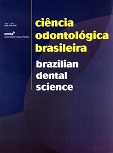Influência das fontes fotoativadoras led e halógena e do tempo de exposição na microdureza knoop de compósitos odontológicos
DOI:
https://doi.org/10.14295/bds.2008.v11i4.660Abstract
O propósito deste estudo foi avaliar a Microdureza Knoop (KHN) das superfícies de topo (T) e fundo (F) de uma resina composta em função dos tempos de exposição de 20 e 40s e das fontes de luz: LD13 ponteira de cristal–GGDent (LED1) e LD13 ponteira de fibra óptica–GGDent (LED2) e halógena-Optilux-Demetron (HAL). As amostras foram confeccionadas em matriz metálica possuindo perfuração central (d=5mm, h=3mm). O compósito (Z250- 3MESPE) foi inserido na cavidade em dois incrementos e as amostras (n=5) foram confeccionadas de acordo com os grupos experimentais G1-LED1/20; G2-LED2/20; G3-HAL/20; G4-LED1/40; G5-LED2/40; G6-HAL/40. Imediatamente após a confecção das amostras, realizou-se o ensaio KHN com carga de 25g por 10s. Executou-se 15 perfurações nas superfícies das amostras (T e F). Os dados foram submetidos à Análise de Variância e ao teste de Comparação Múltipla de Tukey (LSMEANS) obtendo-se os seguintes resultados: G6/F 53,12a; G3/F 51,589abc; G6/T 50,972abc; G3/T 48,803bc; G4/F 47,504cd; G5/F 46,088cd; G5/T 44,495d; G4/T 43,884d; G1/F 39,341e; G2/T 35,300ef; G1/T 37,296ef; G2/F 34,788f. Pôde-se concluir que a fonte hálogena apresentou os maiores valores de microdureza Knoop com comportamento semelhante às fontes com LED no tempo de 40s.
Downloads
Downloads
Published
How to Cite
Issue
Section
License
Brazilian Dental Science uses the Creative Commons (CC-BY 4.0) license, thus preserving the integrity of articles in an open access environment. The journal allows the author to retain publishing rights without restrictions.
=================




























